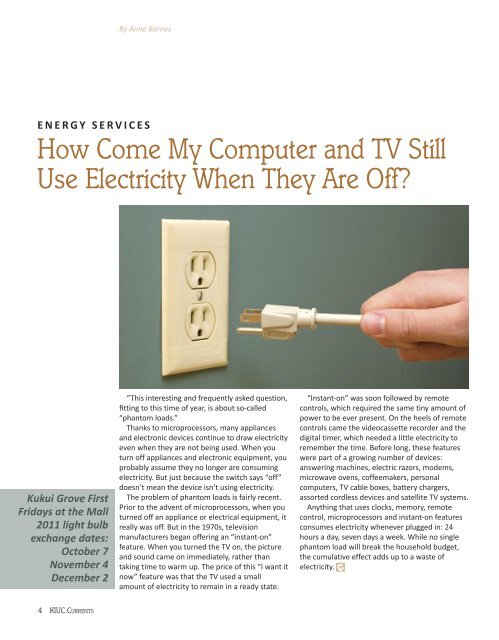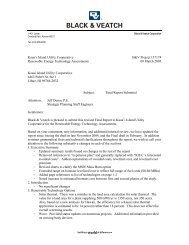KIUC Linemen All Geared Up - Kauai Island Utility Cooperative
KIUC Linemen All Geared Up - Kauai Island Utility Cooperative
KIUC Linemen All Geared Up - Kauai Island Utility Cooperative
You also want an ePaper? Increase the reach of your titles
YUMPU automatically turns print PDFs into web optimized ePapers that Google loves.
ENERGY SERVICES<br />
How Come My Computer and TV Still<br />
Use Electricity When They Are Off?<br />
Kukui Grove First<br />
Fridays at the Mall<br />
2011 light bulb<br />
exchange dates:<br />
October 7<br />
November 4<br />
December 2<br />
4 <strong>KIUC</strong> CURRENTS<br />
By Anne Barnes<br />
“This interesting and frequently asked question,<br />
fitting to this time of year, is about socalled<br />
“phantom loads.”<br />
Thanks to microprocessors, many appliances<br />
and electronic devices continue to draw electricity<br />
even when they are not being used. When you<br />
turn off appliances and electronic equipment, you<br />
probably assume they no longer are consuming<br />
electricity. But just because the switch says “off”<br />
doesn’t mean the device isn’t using electricity.<br />
The problem of phantom loads is fairly recent.<br />
Prior to the advent of microprocessors, when you<br />
turned off an appliance or electrical equipment, it<br />
really was off. But in the 1970s, television<br />
manufacturers began offering an “instanton”<br />
feature. When you turned the TV on, the picture<br />
and sound came on immediately, rather than<br />
taking time to warm up. The price of this “I want it<br />
now” feature was that the TV used a small<br />
amount of electricity to remain in a ready state.<br />
“Instanton” was soon followed by remote<br />
controls, which required the same tiny amount of<br />
power to be ever present. On the heels of remote<br />
controls came the videocassette recorder and the<br />
digital timer, which needed a little electricity to<br />
remember the time. Before long, these features<br />
were part of a growing number of devices:<br />
answering machines, electric razors, modems,<br />
microwave ovens, coffeemakers, personal<br />
computers, TV cable boxes, battery chargers,<br />
assorted cordless devices and satellite TV systems.<br />
Anything that uses clocks, memory, remote<br />
control, microprocessors and instanton features<br />
consumes electricity whenever plugged in: 24<br />
hours a day, seven days a week. While no single<br />
phantom load will break the household budget,<br />
the cumulative effect adds up to a waste of<br />
electricity.
















